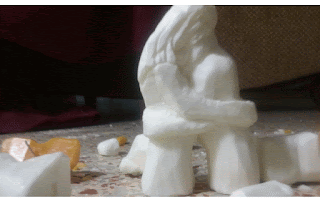Project Description
Together the class will make a miniature working circus. Students will work in pairs to make miniature circus acts. Each act will be 30 seconds long.
You will perform your act on critique day. You may use any materials that you think are appropriate for your idea. We will set up on a table in front of the black wall, so scale your pieces accordingly (2' x 2' x 2'). Describe your act in the comments section, and make sure not to do something someone has already signed up for.
Your act will use the following song for the background music:
Project Schedule
12/04-
For homework (due 12/11) Immediately contact your partner to begin brainstorming ideas. For our next class (12/11) please bring sketches, materials, and your circus act 50% complete. This is what 50% looks like:
1. Stage set is well under way. You have a banner, platform, and backdrop started and you have the materials with you to finish in class. You can use anything to make these. Cardboard with paint and collage could be a good start.
2. Lighting is thought about. What will you use? Your cellphones? Flashlights? stationary or moving? need a spotlight (could you cut something to fit over your phone)?
3. Performers are partially made (what will you need to finish them?)
4. Animation- How will you move your performers? How will you construct them? They can be puppets, or dolls, or marionettes- How will you control them? wire? string? magnets? hand puppet?
5. Props- started and materials with you to finish them.
6. Music and Narrative- How will you use the music? What is going to happen??? THIS IS THE MAIN THING :)
12/11-
Come to class prepared to work, with all sketches & materials for your projects
12/18-
12/18-
Final critique for this project will be an actual performance.
Pairs
Gaby A & Caitlyn V
Kaitlyn C & Isabella C
Sergi E & Alex G
Luciano H & Natasha M
Victoria P & Sophia R
Noah R & Michael S
Alessandra B & Amy A
Cassandra B & Lauren B
Mayee S & Demi C
Enya F & Phoenix M
Galt M & Tamara P
Diego R & Carolina R
Rachel R & Nicola S
Enmanuel C (ringmaster- you will have the job of coordinating all the acts and performing the role of ringmaster for the actual performance day. You will need to make a character for yourself complete with costume. We will talk about this together. Email us)
Research
Many artists have been inspired by the circus. For this project you will research
Alexander Calder- please look up Calder's circus on youtube.
Alexander Calder- please look up Calder's circus on youtube.


































